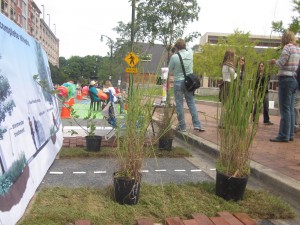We can extol the New England Common and the midwestern town square, but let’s be honest, America’s real public spaces are parking lots. We have turned our landscape over to the car. In his forthcoming book, “ReThinking a Lot,” MIT urban planning professor Eran Ben-Joseph estimates that there are 500 million parking spaces in the US, covering about 3,500 square miles, about the size of Delaware and Rhode Island combined. Other estimates are higher–up to 2 billion spaces; throw in Connecticut and Vermont.
That comparison is a sad statistic on our willingness to turn over civic life to the car; parking lots are an investment in space that seems to be paying out negative social, environmental, and economic impacts. So what to do with all this pavement?
We’ve been looking into zoning and planning opportunities to recreate crossroads and Metro area lots into livable rather than strictly drivable places. In some case, the CR Zones reduce parking requirements significantlycases and also set maximum limits. The zones’ parking standards vary on a sliding scale based on proximity to transit services.
We even participated in Parking Day.
Parking lots really have to serve us twice–as drivers and as walkers–and they have an aesthetic. Landscaping is the most obvious way to create a more nuanced environment.
But this article looks at even looser and more interesting approaches to civic re-use of pavement, including summer theater under the department store port cochere, sports leagues, and the ever-popular food trucks.
To make parking lots more meaningful and attractive public spaces, whether a formal landscaped design or an organic outgrowth of community activity, we have think like people rather than drivers.
Here are more pictures of parking lot re-use, and send us your photos of interesting lots–good and bad.
